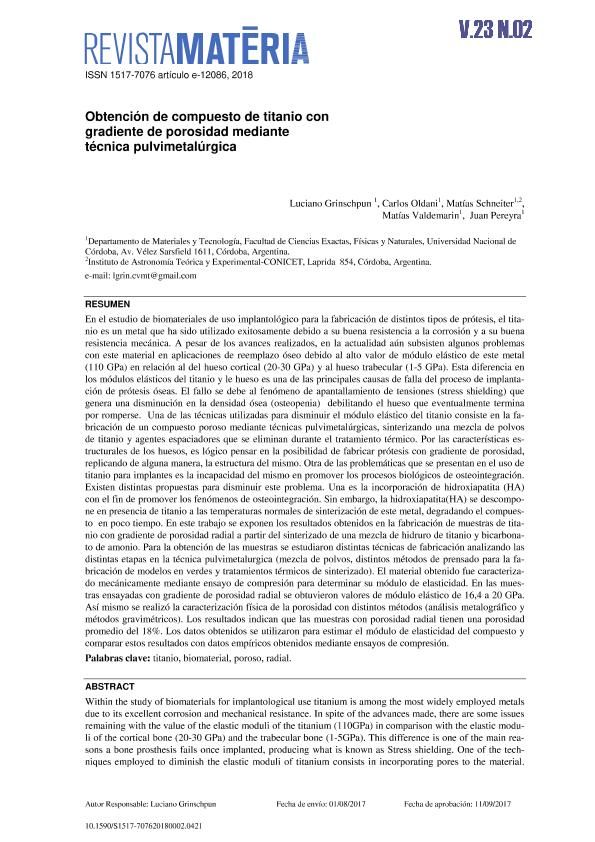Mostrar el registro sencillo del ítem
dc.contributor.author
Grinschpun, Luciano
dc.contributor.author
Oldani, Carlos Rodolfo

dc.contributor.author
Schneiter, Ernesto Matías

dc.contributor.author
Valdemarin, Matías
dc.contributor.author
Pereyra, Juan
dc.date.available
2019-10-24T12:38:11Z
dc.date.issued
2018-07
dc.identifier.citation
Grinschpun, Luciano; Oldani, Carlos Rodolfo; Schneiter, Ernesto Matías; Valdemarin, Matías; Pereyra, Juan; Obtención de compuesto de titanio con gradiente de porosidad mediante técnica pulvimetalúrgica; Universidade Federal do Rio de Janeiro; Matéria; 23; 2; 7-2018
dc.identifier.uri
http://hdl.handle.net/11336/87191
dc.description.abstract
Within the study of biomaterials for implantological use titanium is among the most widely employed metals due to its excellent corrosion and mechanical resistance. In spite of the advances made, there are some issues remaining with the value of the elastic moduli of the titanium (110GPa) in comparison with the elastic moduli of the cortical bone (20-30 GPa) and the trabecular bone (1-5GPa). This difference is one of the main reasons a bone prosthesis fails once implanted, producing what is known as Stress shielding. One of the techniques employed to diminish the elastic moduli of titanium consists in incorporating pores to the material. This is done through powder metallurgy techniques, allowing the fabrications of porous composites, sintering a mix of powders of metallic hydrides and spacers that are eliminated during the heat treatment. Taking into account the structural characteristics of the bone, it makes sense to think on the possibility of fabricating a prosthesis with pore gradients. Another problem encountered when employing titanium, is its inability to promote the osteointegration. There are different techniques to tackle this problem, and one of them is to incorporate hydroxyapatite which has the problem that it decomposes in the presence of titanium when sintered at high temperatures. The current study shows the results obtained during the fabrication of samples of titanium with pore gradients. We studied different fabrication techniques, analyzing each stage during the powder metallurgy. process. The obtained material was characterized mechanically through compression tests, determining the elastic moduli of the composite, which was found to be between 16.4 and 20 GPa. Also, different physical characterization methods where employed to analyse the pore content which was found to be 18%. The obtained data was employed for the estimation of elastic moduli of the compound, and compared to the empirical results obtained with the mechanical tests.
dc.format
application/pdf
dc.language.iso
spa
dc.publisher
Universidade Federal do Rio de Janeiro

dc.rights
info:eu-repo/semantics/openAccess
dc.rights.uri
https://creativecommons.org/licenses/by-nc-sa/2.5/ar/
dc.subject
BIOMATERIAL
dc.subject
POROUS
dc.subject
RADIAL
dc.subject
TITANIUM
dc.subject.classification
Ingeniería de los Materiales

dc.subject.classification
Ingeniería de los Materiales

dc.subject.classification
INGENIERÍAS Y TECNOLOGÍAS

dc.title
Obtención de compuesto de titanio con gradiente de porosidad mediante técnica pulvimetalúrgica
dc.type
info:eu-repo/semantics/article
dc.type
info:ar-repo/semantics/artículo
dc.type
info:eu-repo/semantics/publishedVersion
dc.date.updated
2019-10-17T15:19:35Z
dc.identifier.eissn
1517-7076
dc.journal.volume
23
dc.journal.number
2
dc.journal.pais
Brasil

dc.description.fil
Fil: Grinschpun, Luciano. Universidad Nacional de Córdoba. Facultad de Cs.exactas Físicas y Naturales. Departamento de Materiales y Tecnología; Argentina
dc.description.fil
Fil: Oldani, Carlos Rodolfo. Universidad Nacional de Córdoba. Facultad de Cs.exactas Físicas y Naturales. Departamento de Materiales y Tecnología; Argentina
dc.description.fil
Fil: Schneiter, Ernesto Matías. Universidad Nacional de Córdoba. Facultad de Cs.exactas Físicas y Naturales. Departamento de Materiales y Tecnología; Argentina. Consejo Nacional de Investigaciones Científicas y Técnicas. Centro Científico Tecnológico Conicet - Córdoba. Instituto de Astronomía Teórica y Experimental. Universidad Nacional de Córdoba. Observatorio Astronómico de Córdoba. Instituto de Astronomía Teórica y Experimental; Argentina
dc.description.fil
Fil: Valdemarin, Matías. Universidad Nacional de Córdoba. Facultad de Cs.exactas Físicas y Naturales. Departamento de Materiales y Tecnología; Argentina
dc.description.fil
Fil: Pereyra, Juan. Universidad Nacional de Córdoba. Facultad de Cs.exactas Físicas y Naturales. Departamento de Materiales y Tecnología; Argentina
dc.journal.title
Matéria

dc.relation.alternativeid
info:eu-repo/semantics/altIdentifier/url/http://www.scielo.br/scielo.php?script=sci_abstract&pid=S1517-70762018000200495&lng=en&nrm=iso&tlng=en
dc.relation.alternativeid
info:eu-repo/semantics/altIdentifier/doi/http://dx.doi.org/10.1590/s1517-707620180002.0421
Archivos asociados
